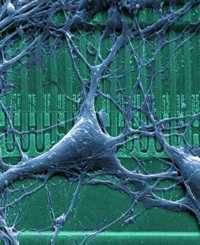
Department of Membrane and Neurophysics, Max-Planck-Institute for Biochemistry, Am Klopferspitz 18a, D-82152 Martinsried, Germany
e-mail: fromherz@biochem.mpg.de

 |
Peter Fromherz
Department of Membrane and Neurophysics, Max-Planck-Institute for Biochemistry, Am Klopferspitz 18a, D-82152 Martinsried, Germany e-mail: fromherz@biochem.mpg.de |
 |
Electrical information processing in brains and computers relies on different charge carriers, ions and electrons. It is a challenge to join the two systems on a microscopic level to get insight of brain dynamics and to develop hybrid processors for medical and technological applications. On the side of electronics, we have to distinguish the two levels of silicon chips with elementary microelectronic devices and of CMOS chips fabricated by very large scale integration. On the biological side, we distinguish the three levels of ion channels, of nerve cells and of brain tissue. We analyzed the geometry and electrical features of the cell-silicon contact with luminescent dyes. We incorporated recombinant ion channels into the cell-chip contact and characterized the physics of signal transmission between electronics and ionics. On that basis, we connected individual nerve cells from snails and rats to silicon chips and created small biolelectronic networks. Finally, we joined tissue layers from rat brain to silicon chips. Recently, we combined ion channels, nerve cells and brain tissue also with CMOS chips. Care was taken that the physics of interfacing was unchanged. Arrays of 128 128 sensor transistors provided electrical maps of snail neurons, neuronal networks and brain tissue.